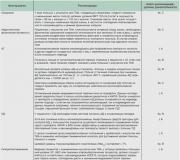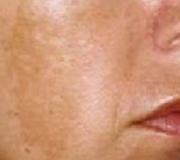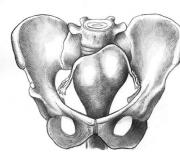Summary of the lesson drawing winter group of early age. Summary of directly educational activities in drawing in an early age group
OLESIA KREZHENOVSKAYA
Goals: introduce children to new (for them) natural phenomenon - snow.
Tasks:
fix the season (winter);
introduce the poem "It's snowing" by M. Poznanskaya;
introduce unconventional form drawing: poke method (cotton balls);
fix white color;
continue to develop fine motor skills of the hands.
Materials and equipment:
plot pictures;
tinted sheet of A5 format, with the image tree;
white gouache;
cotton balls;
wet wipes;
work sample.
Progress:
1. Organizational moment.
caregiver: Guys, let's go to the window. How are you think: "What are these beautiful fluffs falling from the sky?" (Snow.) And what color are they? (White.) Where does the snow fall? (On paths, houses, trees.) Absolutely right: snow falls everywhere. When you went to kindergarten, was it warm or cold? (Cold.) Because winter has come. In winter, it is cold, frosty, it snows outside, and therefore when we go for a walk we put on warm clothes so as not to freeze. And so that we can walk along the paths, our janitor will clear them with shovels. Listen to how the poet described such weather in the poem.
2. The main part. Reading a poem.
Quietly, quietly it snows
White snow, shaggy.
We will clear the snow and ice
In the yard with a shovel.
The teacher shows a plot picture and asks to tell what is shown on it. During the story, the children in chorus and individually words: "winter", "snow", "ice", "shovel", then together with the children re reads a poem.
Physical education "Snowflakes"
We are snowflakes, we are fluffs,
We are not averse to spinning.
We are snowflakes - ballerinas,
We dance day and night.
We the trees have turned white,
The roofs were covered with fluff,
The earth was covered with velvet
and saved from the cold.
Children spin, make smooth movements with their hands, squat.
3. Drawing.
The teacher invites the children to the table.
caregiver: Look at the sheets in front of you, with painted trees. We will draw snowflakes with you, not in the usual way - with cotton balls. And what kind of paint will we be draw snow? (White.) Yes, that's right, do you have such paint? (Children open a jar with the right color). Grab a cotton ball with three fingers (pinching) and put it in a can of paint. Then we dabble on our trees.


4. Reflection
Children, together with the teacher, look at the drawings, repeat the poem.
Related publications:
Abstract of a finger painting lesson in the early age group “Multi-colored leaves” The game is an activity aimed at familiarizing children with artistic and aesthetic activities, using methodological materials of Ph.
Integrated lesson on the topic "Transport" Program content: Be able to listen, answer questions. While looking at pictures.
Synopsis of an integrated lesson on the fairy tale by K. Chukovsky "The Stolen Sun" in the second group of early age Integration of educational areas: Cognition, communication, artistic creativity, reading. Objectives: To introduce children to the content of the passage.
Synopsis of an integrated lesson in the second group of early development. "Flowers for Mom" Program tasks: Learn to remember the name of the season autumn. Introduce children to Mother's Day. Teach children to draw a print.
(2-3 years) Developed by: educator of MDOU "D / s Rossiyanochka" Tsvetkova Zoya Nikolaevna Integration of educational areas: "Cognitive.
R. tasks: creating conditions for the development of speech and cognitive activity of children in the course of direct educational activities.
Abstract of an open integrated lesson in the second group of young children "Winter walk" Purpose: To consolidate children's knowledge about the season - winter. Clarify in children ideas about the characteristic changes in nature, people's clothes in winter.
Topic: “In winter, everything is white all around ...” Purpose: 1. Consolidate knowledge of white flowers; 2. To form the ability to perform a drawing by sticking a brush to a sheet of paper. 3. Maintain interest in visual activity; Material: an illustration depicting a bullfinch, an easel, sheets of blue paper depicting a tree, A5 format, white gouache, brushes for each pupil, cups for water, napkins. The content of organized activities: Children, together with the teacher, stand in a circle. 1. Communication game. We'll stomp first: Top-top-top, top-top-top. (stomp their feet) And then we'll clap: Clap-clap-clap, clap-clap-clap. (clap hands) And then we'll turn around (turn around) And smile at each other. (smile at each other). Children sit on chairs. 2. Directly educational activity: Educator: - Guys, today I went to kindergarten and a bullfinch sat on my shoulder, (show a picture of a bird), he gave you a poem. Listen to me carefully and try to finish it: “It is snowing, under the white cotton wool Streets and houses have disappeared, All the guys are happy with the snow, Winter has come to us again.” That's right, winter has come to replace autumn. Educator: - Tell me, what color did winter paint everything around? Educator: - Yes, winter's favorite color is white, everything is covered with white fluffy snowflakes and the earth, and houses, and trees. How all nature and people are fascinated by winter beauty! I suggest you turn into snowflakes. (children stand in a circle with the teacher) Dynamic pause: - We are funny snowflakes, - We fly like fluffs (circle with a wave of our hands), - A light breeze blew (blow on your palm), - We all gathered in a ball (run into a close-knit circle ), -The wind began to blow harder (blow on the palm with effort), -Dispersed all the snowflakes (return to their places). Educator: - Guys, did you like being snowflakes? Now I suggest you go to the tables and try to draw snowflakes with brushes and paints. (Sheets of paper, brushes, gouache, jars of water, napkins according to the number of children are prepared on the tables in advance). - Let's dress the trees in a beautiful snow coat, cover it with snowflakes! - And we will draw snowflakes with paints, what color? (White) - That's right, today our assistants will be white. -Take the brushes in your hands, soak them in jars of water and carefully pick up a drop of white paint on the brushes. (The teacher is showing the execution of the drawing) - We very carefully stick the brush to a sheet of paper and get beautiful, white snowflakes. (The teacher provides individual guidance assistance, monitors the performance of the creative work of each child) Teacher: - Look at your drawings, what wonderful snowflakes you got! - I think our bullfinch will fly with pleasure to sit on your beautiful trees. Let's please the bullfinch and give him your wonderful drawings in gratitude for the beautiful winter poem!
Download:
Preview:
Topic: “In winter, everything is white around…”
Target:
- To consolidate the knowledge of white flowers;
- To form the ability to perform a drawing by sticking a brush to a sheet of paper.
- Maintain interest in visual activity;
Material: an illustration depicting a bullfinch, an easel, sheets of blue paper depicting a tree, A5 format, white gouache, brushes for each pupil, cups for water, napkins.
The children, along with the teacher, stand in a circle.
1. Communication game.
We will stomp first:
Top-top-top, top-top-top. (stomp feet)
And then we'll clap:
Clap-clap-clap, clap-clap-clap. (clap hands)
And then we'll turn around (turn around)
And we smile at each other. (smile at each other).
Children sit on chairs.
2. Directly educational activities:
Educator: - Guys, today I went to kindergarten and a bullfinch sat on my shoulder (show a picture of a bird), he gave you a poem. Listen to me carefully and try to finish it:
"It's snowing, under white cotton wool
Hidden streets, houses,
All the guys are happy with the snow
Again, winter has come to us.”
That's right, winter has come to replace autumn.
Educator: - Tell me, what color did winter paint everything around?
Educator: - Yes, winter's favorite color is white, everything is covered with white fluffy snowflakes and the earth, and houses, and trees. How all nature and people are fascinated by winter beauty!
I suggest you turn into snowflakes. (children stand in a circle with the teacher)
Dynamic pause:
We are funny snowflakes
We fly like fluffs (circle with a wave of hands),
A light breeze blew (blow on the palm of your hand),
We all gathered in a lump (to run into a close-knit circle),
The wind began to blow harder (blow on the palm with effort),
Dispersed all the snowflakes (return to their places).
Educator: - Guys, did you like being snowflakes? Now I suggest you go to the tables and try to draw snowflakes with brushes and paints.
(Sheets of paper, brushes, gouache, jars of water, napkins according to the number of children are prepared on the tables in advance).
Let's dress the trees in a beautiful snow coat, cover it with snowflakes!
And we will draw snowflakes with paints, what color? (White)
That's right, today our assistants will be white.
Take the brushes in your hands, soak them in jars of water and carefully pick up a drop of white paint on the brushes.
(The teacher is showing the execution of the drawing)
We very carefully stick the brush to a sheet of paper and get beautiful, white snowflakes.
(The teacher provides individual guiding assistance, monitors the performance of the creative work of each child)
Educator: - Look at your drawings, what wonderful snowflakes you got!
I think our bullfinch will gladly come to sit on your beautiful trees. Let's please the bullfinch and give him your wonderful drawings in gratitude for the beautiful winter poem!
Synopsis of directly educational activities on artistic activities in the early age group. Flowers and leaves.
Author: Mishina Natalya ViktorovnaPlace of work: MADOU Malinskiy CRR d/s "Ivushka", Moscow region, Stupinsky district, settlement Malino
GCD on drawing for children of the 1st junior group of the preschool educational institution. Flowers and leaves.
Description: The class is held outside. Creativity in the fresh air is both fun and useful at the same time!
Target: Formation of fine skills and abilities
Tasks:
- to maintain interest in visual activity;
- consolidate knowledge of green and yellow colors;
- development of tactile sensations;
- formation of correct nasal breathing;
- Cultivate accuracy.
Lesson progress
Educator: Guys, look, a butterfly flew to our garden and sat on a cucumber flower. Look at him how beautiful he is. What colour is he? (yellow)

Here is the stem on which it blooms. It's called "stalk". What is this guys? (the teacher points to the sheet) Correct sheet. What color is the stem and leaf? (green).

Go to the flower and touch it with your finger. Now let's sniff it. Oh how delicious it smells! (formation of a deep breath; training of correct nasal breathing).
Guys touch the stem. What does he feel like? (barbed). Now run your hand over the sheet, stroke it. What kind of leaf to the touch? (soft)
Tactile sensations are one of the forms of communication between a young child and the outside world. Currently, there is a scientifically confirmed fact: the functioning of the areas of the cerebral cortex responsible for speech depends on the development of finger movements.
Now let's play a little:
Our hands are like flowers
Fingers like petals.
The flowers open up.
In the dark they are again
The sun is waking up
They will sleep very soundly.
caregiver: Guys, now sit down at the tables. The butterfly really wants us to draw a lot of flowers with leaves for her. Do you want to please her? And what color do we need pencils? (green, yellow).
Look carefully how I will draw. First, I will color the flower with a yellow pencil, carefully without going beyond the line. Then, I will color the stem and leaf with a green pencil, and I will also not go beyond the line. Here's a neat drawing.
Independent work of children. In the course of activities, the educator helps, reminds about accurate drawing.


- Well done boys! Well done. Let's go to the group and hang your drawings in the creative corner. Now the butterfly will fly and look at your flowers.
Material: bunny toy (character of the bibabo theatre), snowballs made of sewn soft material, a large basket, a finger game, a blue-tinted paper sheet with painted silhouettes of Christmas trees, planar figures of a hare and a fox, wet wipes for each child.
Game progress
Educator (V.). Children, I'm going to the kindergarten today and I see a bunny sitting near the door. I felt sorry for the bunny, I took it with me and brought it to the group.
I am a little bunny
That's how white I am.
I'm not cold in winter
In a warm fur coat.
IN. Children, look at the color of the bunny's coat. (White.) And also fluffy and soft.
IN. Bunny, why are you crying?
Bunny. How can I not cry. My fur coat is white, but there is no snow in the forest. The fox sees me and eats me.
IN. Don't cry baby, we'll help you. Play with us, you will have more fun.
Game "Collect the snowballs in the basket."
The teacher scatters snowballs, the children collect them in a basket. The toy bunny disappears imperceptibly. The teacher draws the attention of the children to the fact that the bunny has disappeared.
IN. Let's see where is he?
Children come to the table, where there is a tinted sheet of paper with silhouettes of Christmas trees, a bunny and a fox. The teacher draws their attention to the fact that the bunny is already in the forest.
IN. Children, look who is running after him? Fox! Let's help the bunny hide from the fox. Let's draw many, many snowflakes, and the bunny will not be visible, because the bunny is white as snow.
The teacher shows the finger way of drawing snow.
IN. First, dip your finger in the paint, and then apply it to the paper - we get one snowflake. So that the fox does not see the bunny, we will draw many, many snowflakes. Children draw snow.
While drawing "snow", the teacher reads an excerpt from the poem:
White snow fluffy
Spinning in the air
And the earth is quiet
Falling, laying down.
IN. That's how many snowflakes have been drawn. Snow fell, fell, and the whole earth was covered with snow.
Everyone considers collective work together. The teacher praises the children for beautifully and neatly drawn snowflakes.
IN. Who was the bunny hiding from?
Children. From the fox.
IN. Did we help him hide?
Children. Yes.
IN. And how did we help the bunny hide from the fox? What do we draw with our fingers?
Children. Snow.
IN. Well done boys!
Abstract of the lesson in the second group of early age in fine arts
On the subject: "White snow fell"
Program content: show children that you can draw not only with pencils and a brush, but also with your fingers;
learn to rhythmically apply strokes on paper;
to cultivate accuracy in working with paints;
cause children to enjoy the perception of white snow.
Preliminary work: viewing illustrations depicting winter, reading poetry, watching falling snow.
Methodological material: painting, blue paper, white gouache, napkins.
Methodological techniques: examination, questions to children, game moment, showing the drawing technique, children's action, analysis, musical arrangement.
I hour Children sit in a semicircle on chairs. The teacher shows the children a picture:
What is in the picture? (trees, snow, girl)
How is the girl dressed? (she is wearing a fur coat, hat, warm trousers, boots, mittens)
Why is she wearing warm clothes? (winter, cold)
What lies on the trees, on the ground? (snow)
II hour. The teacher invites the children to play and become a little fluffy snowflakes.
Children stand in a round dance:
Snowflakes - fluffy
Tired of flying
Stopped spinning
Sit down to rest.
Children, standing still, spin around and make flashlights (on the first two lines).
Then the players stop and sit down. (The game is repeated twice). The music is quiet.
III hour The teacher praises the children, invites them to go to the tables and draw a falling snowball.
Today we will draw a snowball, but not with a brush, but with a finger. Now I will show you how to do it. (showing the drawing technique).
And so that the snow is noticeable, we will draw on blue paper. Look what a beautiful drawing I made.
The teacher shows the finished drawing.
That's how beautiful it turned out. And now let's prepare the index finger, dipped it in paint and draw a snowball.
IV hours. After finishing work, the children wipe their hands with napkins. And the teacher invites them to consider their drawings.
Children look at the drawings, admire the snowflakes - fluffs. The teacher praises the children for their work, the lesson is over.




